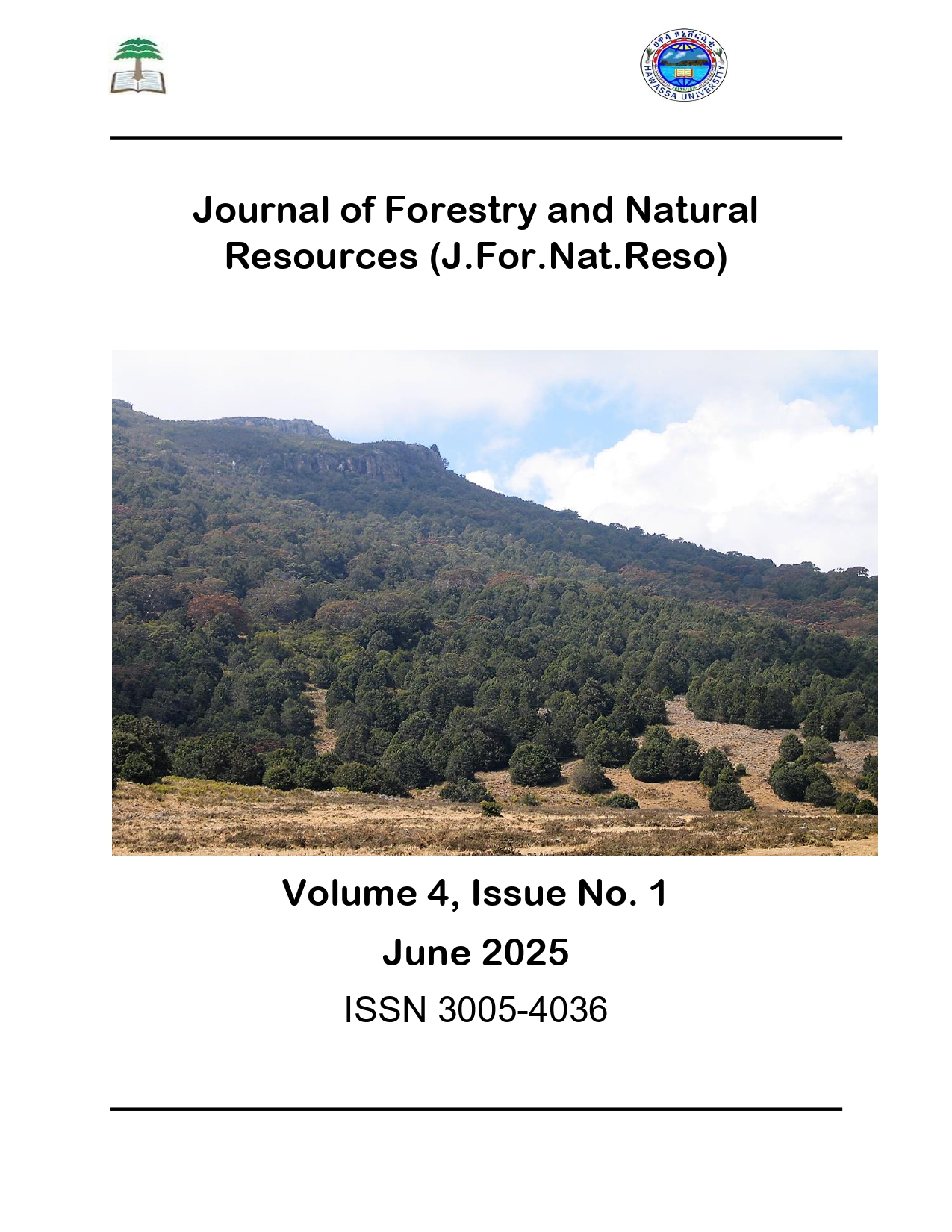Socio-economic utilisation Of Upas Tree (Antiaris toxicaria Lesch):A case study Of Mabira Central Forest Reserve, Uganda
DOI:
https://doi.org/10.20372/JFNR-hu/2025.1469Keywords:
Antiaris toxicaria, forest conservation, Mabira Central Forest Reserve, socio-economic factorsAbstract
Antiaris toxicaria Lesch (upas tree) is a monoecious and medicinal tree species belonging to the Moraceae family and is known for its medicinal value, plywood, and veneer. The tree has been over-utilized, leading to degradation, over-exploitation, and a decrease in population size. The study aims to assess the socio-economic factors associated with the utilization of Antiaris toxicaria Lesch in Mabira Central Forest Reserve. A cross-sectional research design was conducted using a semi-structured questionnaire and participant observation guide from 410 randomly selected households across 10 villages. A total of 10 key informant interviews were also conducted among persons who were knowledgeable persons about the upas tree and Mabira Central Forest service. Descriptive statistics and inferential statistics (chi-square tests) were used for analysis. Results indicate eight primary uses of the tree, with timber (42.1%) and medicinal (23.6%) uses being the most common while firewood (0.9%) and fertilization (2.3%) ranked least. Significant factors influencing utilization of upas trees included residence duration (p=0.001), occupation (p=0.002), and household income (p=0.028). The National Forestry Authority and local government should work hand in hand with local communities to protect Mabira Central Forest Reserve and promote upas tree domestication. The study recommends conservation awareness among communities living in the vicinity and inclusive policies for sustainable use of upas trees.
References
REFERENCES
Abdourhamane, H., Morou, B., Larwanou, M., Mahamane, A., Saadou, M., & Ronald, B. (2015). Uses and preferences of woody species in two protected forests of Dan Kada Dodo and Dan Gado in Niger. Journal of Horticulture and Forestry, 7(6), 149–159. https://doi.org/10.5897/jhf2014.0374
Andriamparany, J. N., Brinkmann, K., Jeannoda, V., & Buerkert, A. (2014). Effects of socio-economic household characteristics on traditional knowledge and usage of wild yams and medicinal plants in the Mahafaly region of south-western Madagascar. Journal of Ethnobiology and Ethnomedicine, 10(1). https://doi.org/10.1186/1746-4269-10-82
Bari, M. R., Ali, M. A., Miah, M. G., Abbdullah, M. R., & Uddin, M. J. (2017). Medicinal plants and their contribution in socio-economic condition of the household in Haluaghat upazila, Mymensingh. International Journal of Business Management and Social Research, 4(1), 215–228. https://doi.org/10.18801/ijbmsr.040117.25
Corroto, F., Gamarra Torres, O. A., & Macía, M. J. (2022). Understanding the Influence of Socioeconomic Variables on Medicinal Plant Knowledge in the Peruvian Andes. Plants, 11(20), 2681. https://doi.org/10.3390/plants11202681
Emmanuelle, R., Darshil, S., Sylvie, D., Victor, G., Camille, G., Delphin, P., Dieuveil, N., Sylvie, C., Hom, D., Sofiane, G., Richard, S., Catherine, L., David, L., Guilhem, B., Johnny, B., Alain, B. (2024). Bark cloth structure and properties: A naturally occurring fabric and ancestral textile craft from Uganda, Industrial Crops and Products, 215,118613, ISSN 0926-6690, https://doi.org/10.1016/j.indcrop.2024.118613
Koros, Hillary & Malombe, Itambo & Mwendwa, Kaleb & Jeruto, Pascaline & Humphrey, Agevi & Konje, Martha. (2016). Indigenous Knowledge, Uses, and Conservation of Prunus africana (Hook. F.) Kalkman in Nandi Forests. Wuhan University Journal of Natural Sciences. 6. 58-62.
Logiel, A., Jørs, E., Akugizibwe, P., & Ahnfeldt-Mollerup, P. (2021). Prevalence and socio-economic factors affecting the use of traditional medicine among adults of katikekile subcounty, moroto district, Uganda. African Health Sciences, 21(3), 1410–1417. https://doi.org/10.4314/ahs.v21i3.52
Mirgal, A., Gunaga, R., & Salunkhe, C., (2016). Seed traits, germination pattern and seedling vigour in Antiaris toxicaria (Pers.) Lesch., a rare plant species of Western ghats. JANS. 8. 1710-1713. 10.31018/jans. v8i3.1027.
Ministry of Water and Environment (2017). Revised forest management plan for Mabira central forest reserves. Uganda Government Printer, 2020(July 2010-June 2020), 191.
Ministry of Water and Environment (2020). Mabira central forest reserves. Revised Forest Management Plan, 2020(6), 67.
Mwendwa, K. (2016). Indigenous Knowledge, Uses, and Conservation of Prunus africana (Hook. F.) Kalkman in Nandi Forests. Figure 1, 56–62.
Obakiro, S. B., Kiprop, A., Kowino, I., Kigondu, E., Odero, M. P., Omara, T., & Bunalema, L. (2020). Ethnobotany, ethnopharmacology, and phytochemistry of traditional medicinal plants used in the management of symptoms of tuberculosis in East Africa: A systematic review. Tropical Medicine and Health, 48(1), 1–21. https://doi.org/10.1186/s41182-020-00256-1
Ouinsavi, C., Nawan, B., Sourou, K., Wédjangnon, A. A., Houêtchégnon, T., Akin, Y., & Dossou, J. (2021). Traditional uses of African rosewood ( Pterocarpus erinaceus Poir . Fabaceae ) through the sociolinguistic groups and the pathways of conservation and sustainable management in Benin. 13(December), 200–213. https://doi.org/10.5897/IJBC2021.1509
Seid, M. A., Mulatu, Y., Anjulo, A., Ayalew, S., Belay, H., Nigatu, M., & Kebede, W. (2020). Population survey of Milicia excelsa, Pouteria adolfi-fridercii, Antiaris toxicaria and Prunus africana in south and south-western Ethiopia: implications for domesticating and establishing Seed Production Areas. MOJ Ecology & Environmental Sciences, 5(4), 153–162. https://doi.org/10.15406/mojes.2020.05.00188
Subiono, T., Abadi, L., Himawan, T., & Utomo, E. P. (2017). Ligan Activity of Antiaris toxicaria Lesch and the Role of Toxicarioside in Crude Extract : In Silico , In Vitro , and In Vivo Approaches. 3(6), 4–10. https://doi.org/10.9790/264X-03060410
Tumuhe, C., Mwine, R., & Manana, S. (2018). Population Structure and Regeneration Status of Most Abundant Medicinal Woody Plants in Mabira Central Forest Reserve Management Zones. Environment, Earth and Ecology, 2(1), 6–11. https://doi.org/10.24051/eee/84900
UBOS. (2014). Uganda National Population and Housing Census 2014. Revised Edition. Uganda Bureau of Statistics, Appendix I: Page 21. http://search.tb.ask.com/search/GGmain.jhtml?p2=%5EYN%5Exdm095%5EYYA%5Eug&si=8812&ptb=6D1F8A55-326A-43E1-B00E-03A6AA884C84&ind=2014061601&n=780c2421&st=bar&searchfor=+UBOS+2014
Ugwoke, C., Anze, S., Nweze, A., & Obisike, C. (2017). Pharmacognostic Evaluation of the Leaf of Antiaris Toxicaria (Family: Moraceae). International Journal of Pharmaceutical Sciences and Research, 8(January), 2696–2700. https://doi.org/10.13040/IJPSR.0975-8232.8(6).2696-00
Umdale, S. D., Mirgal, A. B., Shinde, B. N., Sawant, R. S., Salunkhe, C. B., & Gaikwad, N. B. (2020). Evaluation of Genetic Diversity in Antiaris toxicaria Lesch.from Sacred Groves of the Western Ghats, India. National Academy Science Letters, 43(4), 383–388. https://doi.org/10.1007/s40009-020-00878-3
Yamane, Y. (1967). Mathematical Formulae for Sample Size Determination.
Wayland, C., & Walker, L. S. (2014). Length of residence, age, and patterns of medicinal plant knowledge and use among women in the urban Amazon. Journal of Ethnobiology and Ethnomedicine, 10(1), 1–11. https://doi.org/10.1186/1746-4269-10-25

